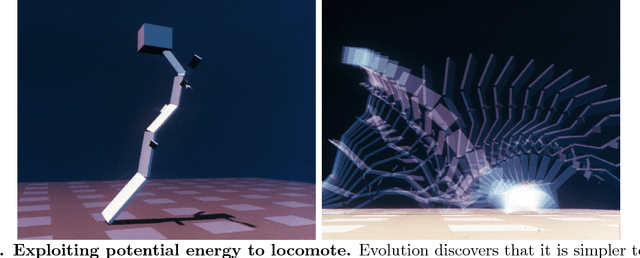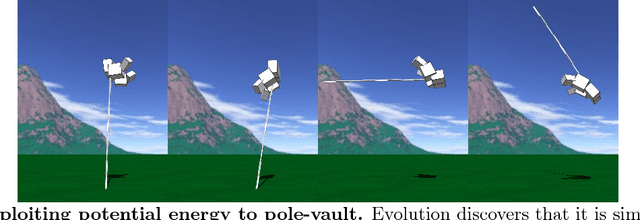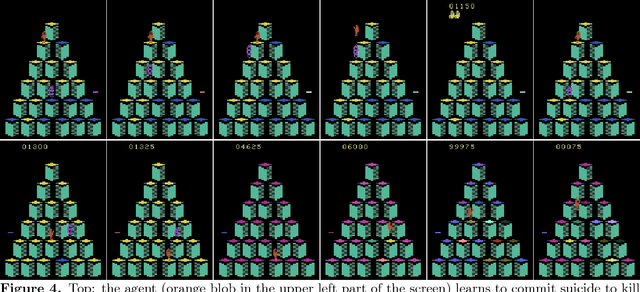Peter J. Bentley
Situating AI Agents in their World: Aspective Agentic AI for Dynamic Partially Observable Information Systems
Sep 03, 2025Abstract:Agentic LLM AI agents are often little more than autonomous chatbots: actors following scripts, often controlled by an unreliable director. This work introduces a bottom-up framework that situates AI agents in their environment, with all behaviors triggered by changes in their environments. It introduces the notion of aspects, similar to the idea of umwelt, where sets of agents perceive their environment differently to each other, enabling clearer control of information. We provide an illustrative implementation and show that compared to a typical architecture, which leaks up to 83% of the time, aspective agentic AI enables zero information leakage. We anticipate that this concept of specialist agents working efficiently in their own information niches can provide improvements to both security and efficiency.
* 9 pages
CLEAR: Cue Learning using Evolution for Accurate Recognition Applied to Sustainability Data Extraction
Jan 30, 2025



Abstract:Large Language Model (LLM) image recognition is a powerful tool for extracting data from images, but accuracy depends on providing sufficient cues in the prompt - requiring a domain expert for specialized tasks. We introduce Cue Learning using Evolution for Accurate Recognition (CLEAR), which uses a combination of LLMs and evolutionary computation to generate and optimize cues such that recognition of specialized features in images is improved. It achieves this by auto-generating a novel domain-specific representation and then using it to optimize suitable textual cues with a genetic algorithm. We apply CLEAR to the real-world task of identifying sustainability data from interior and exterior images of buildings. We investigate the effects of using a variable-length representation compared to fixed-length and show how LLM consistency can be improved by refactoring from categorical to real-valued estimates. We show that CLEAR enables higher accuracy compared to expert human recognition and human-authored prompts in every task with error rates improved by up to two orders of magnitude and an ablation study evincing solution concision.
Address-Specific Sustainable Accommodation Choice Through Real-World Data Integration
May 21, 2024



Abstract:Consumers wish to choose sustainable accommodation for their travels, and in the case of corporations, may be required to do so. Yet accommodation marketplaces provide no meaningful capability for sustainable choice: typically CO2 estimates are provided that are identical for all accommodation of the same type across an entire country. We propose a decision support system that enables real choice of sustainable accommodation. We develop a data-driven address-specific metric called EcoGrade, which integrates government approved datasets and uses interpolation where data is sparse. We validate the metric on 10,000 UK addresses in 10 cities, showing the match of our interpolations to reality is statistically significant. We show how the metric has been embedded into a decision support system for a global accommodation marketplace and tested by real users over several months with positive user feedback. In the EU, forty percent of final energy consumption is from buildings. We need to encourage all building owners to make their accommodation more efficient. The rental sector is one area where change can occur rapidly, as rented accommodation is renovated frequently. We anticipate our decision support system using EcoGrade will encourage this positive change.
Using a Variational Autoencoder to Learn Valid Search Spaces of Safely Monitored Autonomous Robots for Last-Mile Delivery
Mar 06, 2023Abstract:The use of autonomous robots for delivery of goods to customers is an exciting new way to provide a reliable and sustainable service. However, in the real world, autonomous robots still require human supervision for safety reasons. We tackle the realworld problem of optimizing autonomous robot timings to maximize deliveries, while ensuring that there are never too many robots running simultaneously so that they can be monitored safely. We assess the use of a recent hybrid machine-learningoptimization approach COIL (constrained optimization in learned latent space) and compare it with a baseline genetic algorithm for the purposes of exploring variations of this problem. We also investigate new methods for improving the speed and efficiency of COIL. We show that only COIL can find valid solutions where appropriate numbers of robots run simultaneously for all problem variations tested. We also show that when COIL has learned its latent representation, it can optimize 10% faster than the GA, making it a good choice for daily re-optimization of robots where delivery requests for each day are allocated to robots while maintaining safe numbers of robots running at once.
The Agent-based Modelling for Human Behaviour Special Issue
Feb 06, 2023Abstract:If human societies are so complex, then how can we hope to understand them? Artificial Life gives us one answer. The field of Artificial Life comprises a diverse set of introspective studies that largely ask the same questions, albeit from many different perspectives: Why are we here? Who are we? Why do we behave as we do? Starting with the origins of life provides us with fascinating answers to some of these questions. However, some researchers choose to bring their studies closer to the present day. We are after all, human. It has been a few billion years since our ancestors were self-replicating molecules. Thus, more direct studies of ourselves and our human societies can reveal truths that may lead to practical knowledge. The papers in this special issue bring together scientists who choose to perform this kind of research.
* extended version with references
Temporally Extended Successor Representations
Sep 25, 2022



Abstract:We present a temporally extended variation of the successor representation, which we term t-SR. t-SR captures the expected state transition dynamics of temporally extended actions by constructing successor representations over primitive action repeats. This form of temporal abstraction does not learn a top-down hierarchy of pertinent task structures, but rather a bottom-up composition of coupled actions and action repetitions. This lessens the amount of decisions required in control without learning a hierarchical policy. As such, t-SR directly considers the time horizon of temporally extended action sequences without the need for predefined or domain-specific options. We show that in environments with dynamic reward structure, t-SR is able to leverage both the flexibility of the successor representation and the abstraction afforded by temporally extended actions. Thus, in a series of sparsely rewarded gridworld environments, t-SR optimally adapts learnt policies far faster than comparable value-based, model-free reinforcement learning methods. We also show that the manner in which t-SR learns to solve these tasks requires the learnt policy to be sampled consistently less often than non-temporally extended policies.
Kill Chaos with Kindness: Agreeableness Improves Team Performance Under Uncertainty
Aug 09, 2022



Abstract:Teams are central to human accomplishment. Over the past half-century, psychologists have identified the Big-Five cross-culturally valid personality variables: Neuroticism, Extraversion, Openness, Conscientiousness, and Agreeableness. The first four have shown consistent relationships with team performance. Agreeableness (being harmonious, altruistic, humble, and cooperative), however, has demonstrated a non-significant and highly variable relationship with team performance. We resolve this inconsistency through computational modelling. An agent-based model (ABM) is used to predict the effects of personality traits on teamwork and a genetic algorithm is then used to explore the limits of the ABM in order to discover which traits correlate with best and worst performing teams for a problem with different levels of uncertainty (noise). New dependencies revealed by the exploration are corroborated by analyzing previously-unseen data from one the largest datasets on team performance to date comprising 3,698 individuals in 593 teams working on more than 5,000 group tasks with and without uncertainty, collected over a 10-year period. Our finding is that the dependency between team performance and Agreeableness is moderated by task uncertainty. Combining evolutionary computation with ABMs in this way provides a new methodology for the scientific investigation of teamwork, making new predictions, and improving our understanding of human behaviors. Our results confirm the potential usefulness of computer modelling for developing theory, as well as shedding light on the future of teams as work environments are becoming increasingly fluid and uncertain.
PiNet: Attention Pooling for Graph Classification
Aug 11, 2020


Abstract:We propose PiNet, a generalised differentiable attention-based pooling mechanism for utilising graph convolution operations for graph level classification. We demonstrate high sample efficiency and superior performance over other graph neural networks in distinguishing isomorphic graph classes, as well as competitive results with state of the art methods on standard chemo-informatics datasets.
* 4 pages, 3 figures 1 table
PiNet: A Permutation Invariant Graph Neural Network for Graph Classification
May 08, 2019



Abstract:We propose an end-to-end deep learning learning model for graph classification and representation learning that is invariant to permutation of the nodes of the input graphs. We address the challenge of learning a fixed size graph representation for graphs of varying dimensions through a differentiable node attention pooling mechanism. In addition to a theoretical proof of its invariance to permutation, we provide empirical evidence demonstrating the statistically significant gain in accuracy when faced with an isomorphic graph classification task given only a small number of training examples. We analyse the effect of four different matrices to facilitate the local message passing mechanism by which graph convolutions are performed vs. a matrix parametrised by a learned parameter pair able to transition smoothly between the former. Finally, we show that our model achieves competitive classification performance with existing techniques on a set of molecule datasets.
The Surprising Creativity of Digital Evolution: A Collection of Anecdotes from the Evolutionary Computation and Artificial Life Research Communities
Aug 14, 2018



Abstract:Biological evolution provides a creative fount of complex and subtle adaptations, often surprising the scientists who discover them. However, because evolution is an algorithmic process that transcends the substrate in which it occurs, evolution's creativity is not limited to nature. Indeed, many researchers in the field of digital evolution have observed their evolving algorithms and organisms subverting their intentions, exposing unrecognized bugs in their code, producing unexpected adaptations, or exhibiting outcomes uncannily convergent with ones in nature. Such stories routinely reveal creativity by evolution in these digital worlds, but they rarely fit into the standard scientific narrative. Instead they are often treated as mere obstacles to be overcome, rather than results that warrant study in their own right. The stories themselves are traded among researchers through oral tradition, but that mode of information transmission is inefficient and prone to error and outright loss. Moreover, the fact that these stories tend to be shared only among practitioners means that many natural scientists do not realize how interesting and lifelike digital organisms are and how natural their evolution can be. To our knowledge, no collection of such anecdotes has been published before. This paper is the crowd-sourced product of researchers in the fields of artificial life and evolutionary computation who have provided first-hand accounts of such cases. It thus serves as a written, fact-checked collection of scientifically important and even entertaining stories. In doing so we also present here substantial evidence that the existence and importance of evolutionary surprises extends beyond the natural world, and may indeed be a universal property of all complex evolving systems.
 Add to Chrome
Add to Chrome Add to Firefox
Add to Firefox Add to Edge
Add to Edge